Key takeaways:
- Keynote storytelling enhances presentations by creating emotional connections, making content more relatable and memorable.
- Effective stories have a clear arc and vivid imagery, engaging the audience’s emotions and encouraging reflection on their own experiences.
- Incorporating personal anecdotes and audience engagement techniques fosters a deeper connection, transforming passive listeners into active participants.
- Using customer insights and ensuring each story has a clear takeaway strengthens the overall impact of storytelling in presentations.
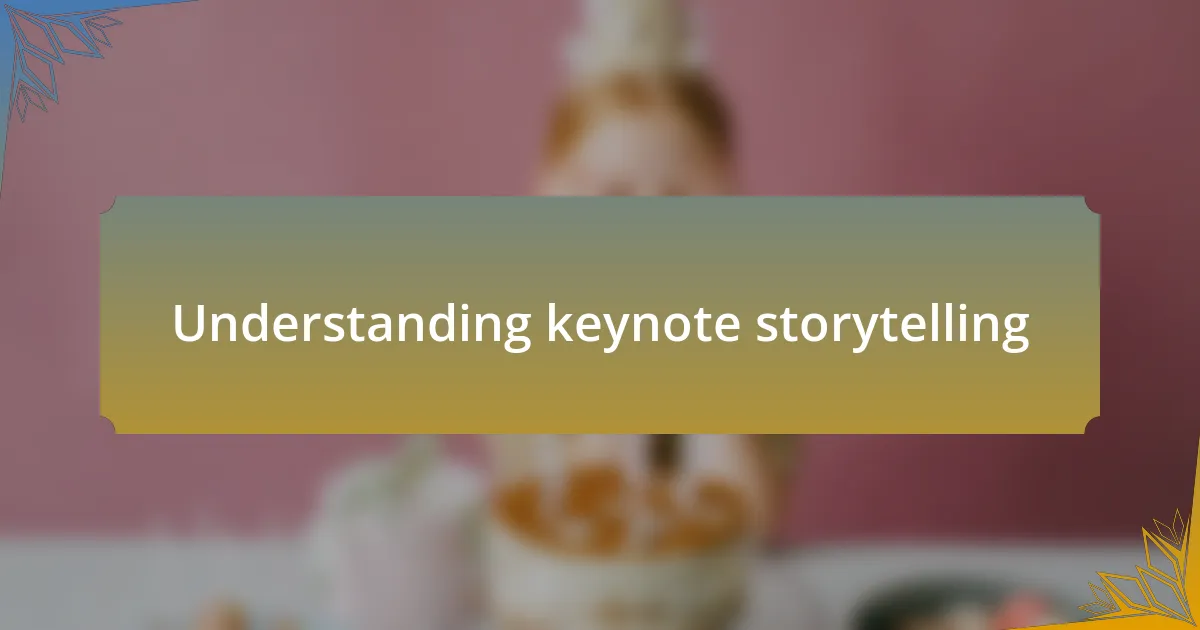
Understanding keynote storytelling
Keynote storytelling is more than just sharing facts; it’s about weaving a narrative that resonates with the audience. I still remember the first time I attended a conference where a speaker used personal stories to illustrate their points. The way they connected their journey to the topic at hand made the experience incredibly memorable, proving that stories create emotional bonds that data alone cannot.
Have you ever felt truly captivated by a speaker? That sense of engagement often stems from a well-crafted story that reflects vulnerability and authenticity. When I share my own experiences, especially moments of failure or unexpected success, I notice how it sparks deeper connections with my audience. It turns abstract concepts into relatable experiences, making the content feel both personal and impactful.
In essence, keynote storytelling transforms a presentation into a shared journey. I find that the most effective stories are those that invite the audience to reflect on their own experiences as well. By asking thought-provoking questions and sharing genuine emotions, I create a space where listeners feel seen and heard, ultimately enhancing their overall experience and retention of the message.
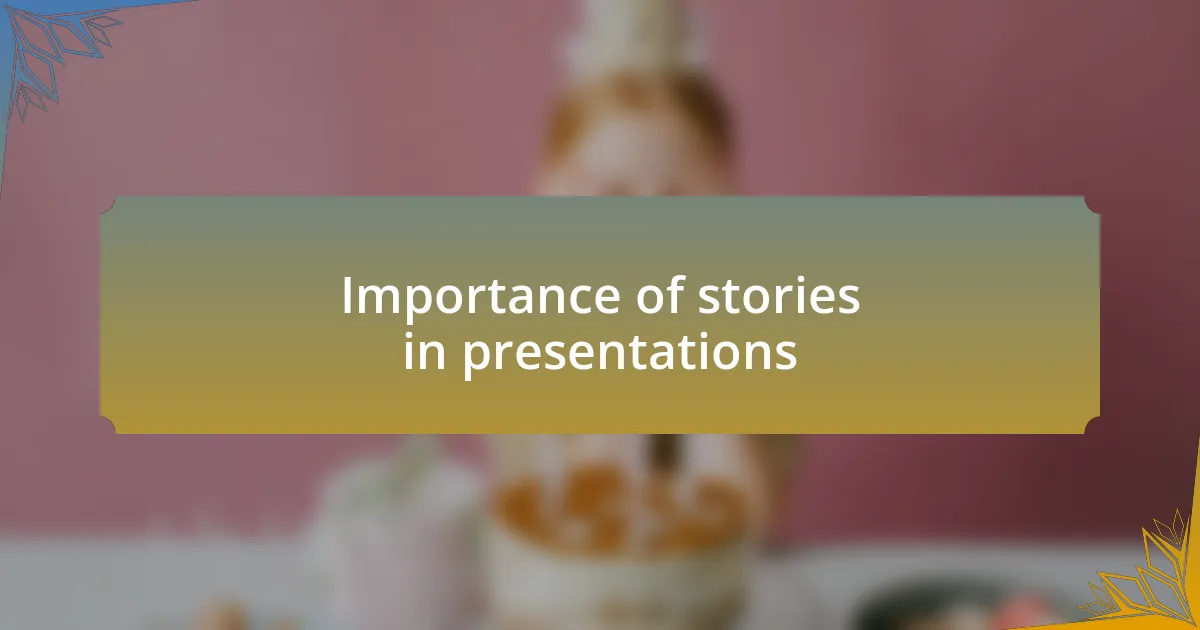
Importance of stories in presentations
Stories serve as the heart of any compelling presentation, acting as a bridge between information and the audience. I recall a time when I noticed a shift in the room during a presentation that included a poignant story about overcoming a challenge. Suddenly, the air felt charged with empathy and understanding. This is the power of storytelling; it has the ability to turn passive listeners into active participants, encouraging them to relate and reflect.
Think about the last time you heard a story that resonated with you. What made it stick? In my experience, it’s the emotions that linger long after the presentation is over. When I incorporate narratives filled with personal struggles or triumphs, I see the audience nodding in recognition, connecting their own experiences to what I’m sharing. This emotional engagement is what transforms mere data into lasting impressions.
Moreover, stories help simplify complex ideas, making them accessible and memorable. For instance, I often use metaphors drawn from everyday life to illustrate industry concepts. It’s fascinating how a simple anecdote about preparing a meal can clarify intricate strategies in customer experience. This technique not only captures attention but also ensures that the core message resonates well beyond the presentation itself, sparking meaningful conversations long after the event concludes.
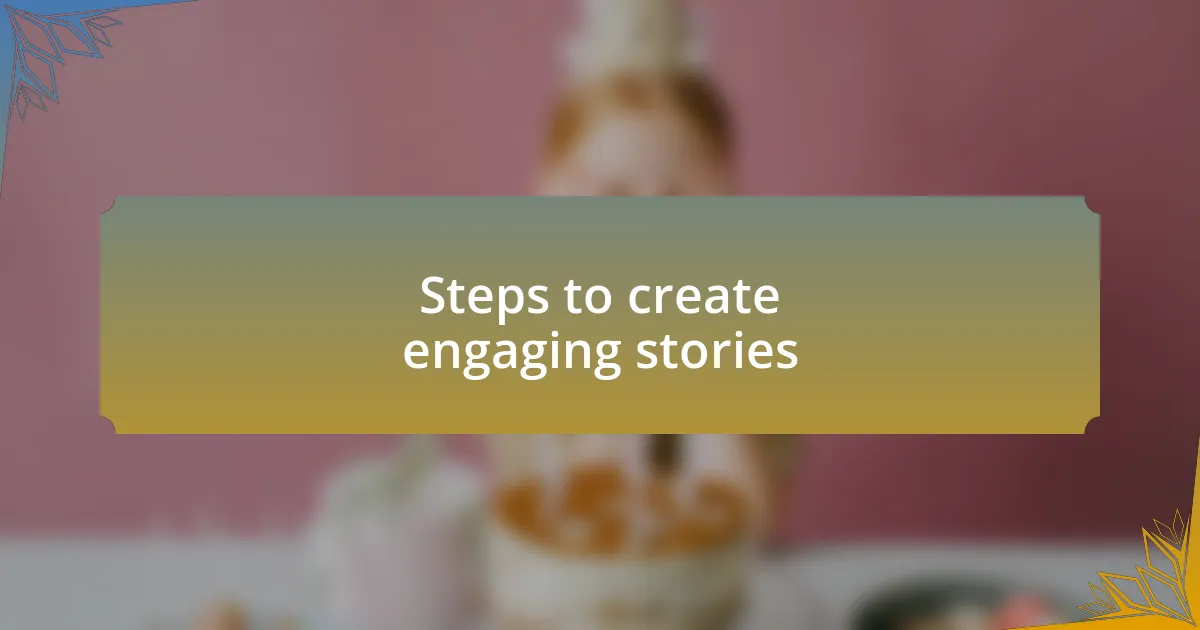
Steps to create engaging stories
Crafting engaging stories begins with knowing your audience. I often think about my early days of presenting; I would throw in a story without considering who was listening. Then, I realized that tailoring my narrative to their experiences makes a significant difference. Have you ever noticed how a well-timed joke or relatable scenario can brighten up a room? Understanding your audience’s interests and pain points helps you create connections that resonate deeply.
Next, I focus on creating a strong arc in my stories. This means having a clear beginning, middle, and end. One time, I shared my own journey of failure before launching a successful product. The tension built up effectively as I recounted the setbacks, leading to an “aha” moment when I ultimately found success. This structure not only keeps listeners engaged but also helps them follow along easily, making the resolution all the more satisfying.
Lastly, I believe in the power of vivid imagery. When I describe a moment, I try to paint a picture with words. Think of your favorite book or movie; scenes are not just described—they’re felt. A few years back, I recounted a customer experience by describing the bustling atmosphere of a café I visited, allowing the audience to visualize the hustle and bustle. This brings stories to life and makes the message unforgettable. How do you evoke those details in your storytelling? It often comes down to sharing personal experiences that feel authentic and personal, striking a chord with your audience.
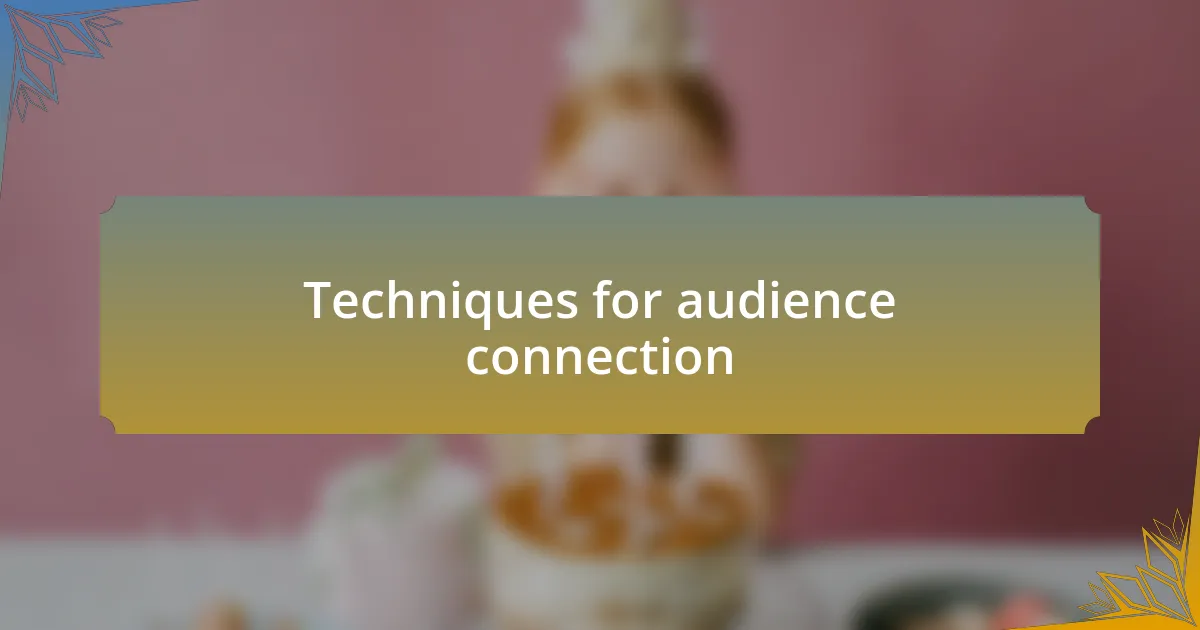
Techniques for audience connection
Techniques for audience connection
One of the most effective techniques I’ve found for connecting with an audience is the use of personal anecdotes. For instance, I once shared a story about a moment of vulnerability in my career—a time when I faced a significant challenge that many in the audience could relate to. I could see heads nodding in agreement, and it struck me how this shared understanding bridged the gap between me and the audience. Have you ever witnessed a moment when someone’s honesty transformed the atmosphere in the room? It’s truly powerful.
In addition to anecdotes, I often ask questions to spark engagement and keep listeners active. A while back, during a presentation, I posed a question that encouraged the audience to reflect on their own experiences. “Have you ever felt overwhelmed by customer feedback?” This simple query opened a dialogue in their minds, leading them to connect my story to their own realities. I’ve found that people love to think about their experiences, and asking questions can make them feel included in the narrative.
Emotional storytelling is also crucial for audience connection. When I share experiences filled with genuine emotion—like the joy of helping a customer resolve an issue—listeners can feel the passion behind my words. This emotional resonance invites them to experience the story alongside me. I remember describing a moment where a simple act of kindness turned a customer’s day around, and I could sense the room’s collective warmth. Real connection often stems from genuine emotion, don’t you think?

Personal anecdotes that resonate
I recall an experience early in my career when I had to deliver a presentation to a group of clients who were skeptical about our product. I shared a story about my own apprehension before using the service. I walked them through my journey, detailing how my initial doubts changed when I saw the product in action, and I could feel the shift in their expressions. It was as if my honesty opened a door for them to reconsider their own hesitations.
There was a time when I encountered a particularly frustrated customer, and instead of sticking to a script, I shared a heartfelt personal moment of dealing with a similar situation in my own life. I talked about how my vulnerability allowed me to genuinely empathize with that customer, leading to an unexpected resolution that not only salvaged a client relationship but impacted my outlook on customer service. Have you ever thought about how vulnerabilities can build trust? That moment truly emphasized the power of storytelling rooted in real experience.
During a workshop where I discussed effective communication, I shared how a small gesture—like sending a handwritten thank-you note—transformed a client relationship. That personal touch turned a simple transaction into a memorable experience, creating a lasting bond. It made me realize that sometimes, the little moments resonate more profoundly than grand successes. Have you ever found that a small, thoughtful gesture made a big difference? I believe those are the moments that stay with us, bridging connections that data alone can’t achieve.
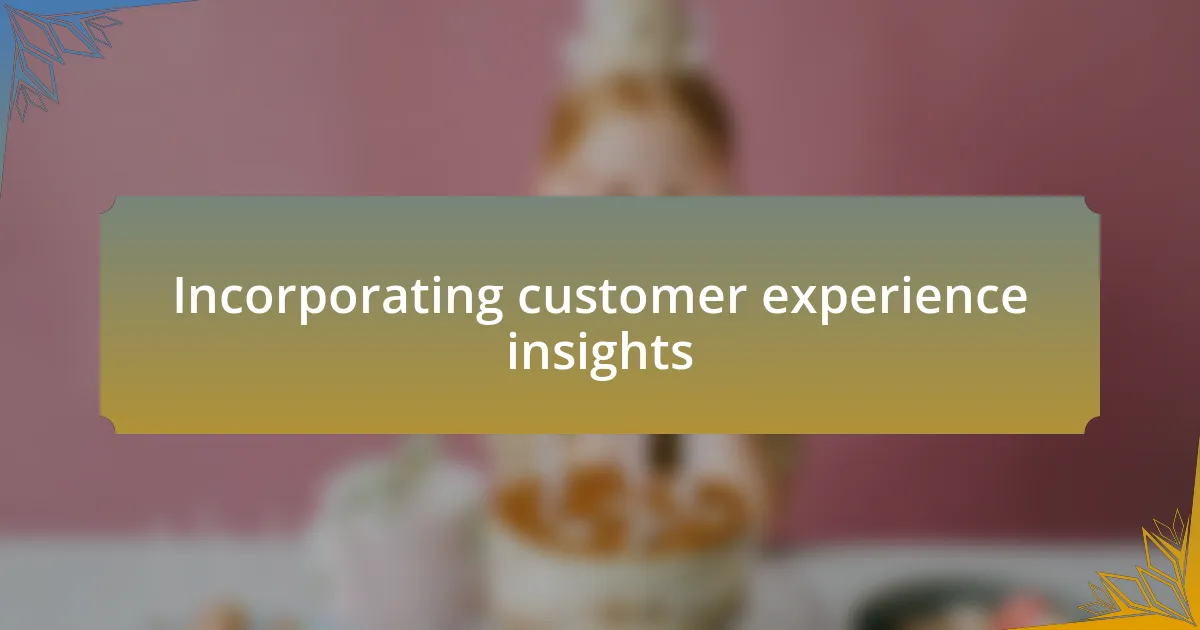
Incorporating customer experience insights
When thinking about incorporating customer experience insights, I’ve found that it’s all about listening actively. I remember a time during a focus group where a participant shared their frustration with a common product flaw. Instead of dismissing their feelings, I leaned in, taking copious notes and validating their concerns. That simple act of truly hearing them not only enriched my understanding but also shaped how we refined our product. Isn’t it fascinating how one person’s experience can illuminate a path for everyone?
Another instance comes to mind when I facilitated a workshop for our team. One of my colleagues presented a customer’s journey that highlighted not just the successes but also the pain points. We discussed how those insights not only added depth to our strategy but actually transformed our approach to customer support. Reflecting on this, I often wonder: how many opportunities for improvement might we miss if we don’t prioritize these insights in our storytelling?
In another project, I saw a remarkable transformation in our marketing materials after integrating direct quotes from satisfied customers. Instead of dry statistics, we showcased real-life stories that captured authentic experiences. It was amazing to witness how these narratives resonated more deeply with our audience, as they reflected relatable emotions and motivations. Have you ever noticed how a single customer voice can echo through a room, making everyone pay attention? That’s the incredible power of using genuine customer insights.
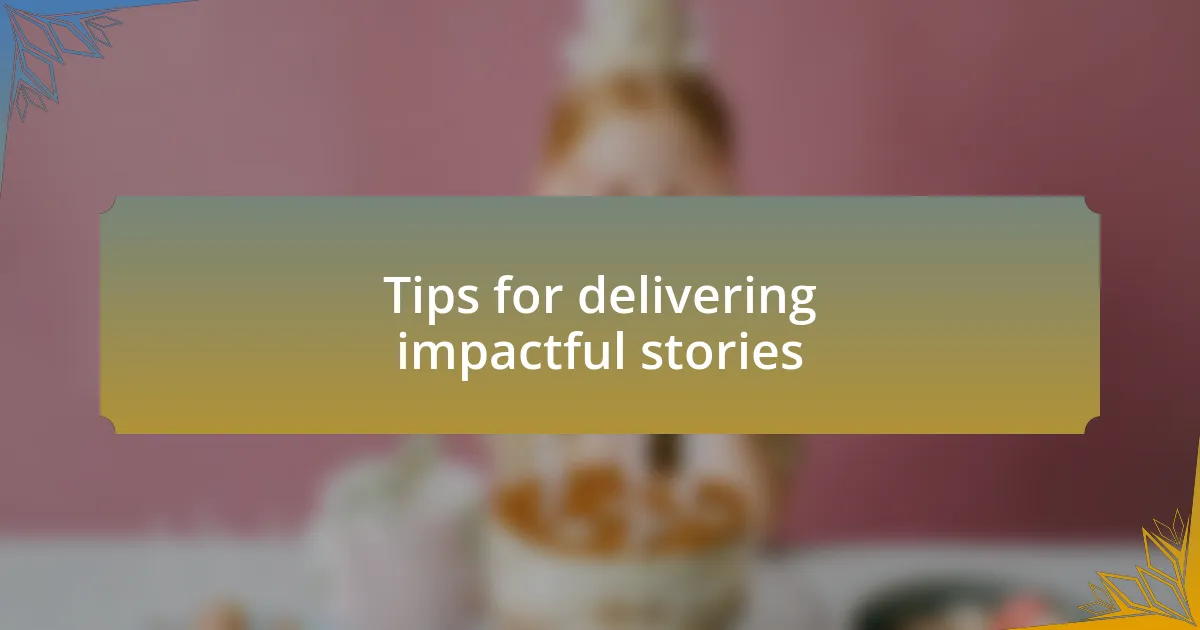
Tips for delivering impactful stories
When delivering impactful stories, I’ve learned the importance of tapping into emotion. I recall a presentation where I shared a story about a family’s experience with our service during a challenging time. Witnessing how my audience’s expressions shifted as I painted that picture reminded me that stories connect on a profound level. Have you ever felt a lump in your throat during a touching tale? That’s the kind of emotional resonance that makes your story stick.
Another tip is to use vivid imagery to transport your audience into your narrative. For instance, when recounting a pivotal moment in my career, I described the chaotic atmosphere of a launch event, from electric anticipation to the palpable relief when everything went smoothly. By immersing the audience in those details, I noticed their engagement deepened. Don’t you think that crafting a scene helps people visualize the experience more clearly?
Lastly, it’s crucial to have a clear takeaway. One time, I shared a story that ended with a distinct lesson about perseverance in customer service. I wanted my audience to not only feel inspired but to also walk away with actionable insights. Isn’t it satisfying when a story leaves an impact, prompting others to reflect on their own experiences? Ensuring that each narrative is rooted in a strong message can truly amplify its effectiveness.